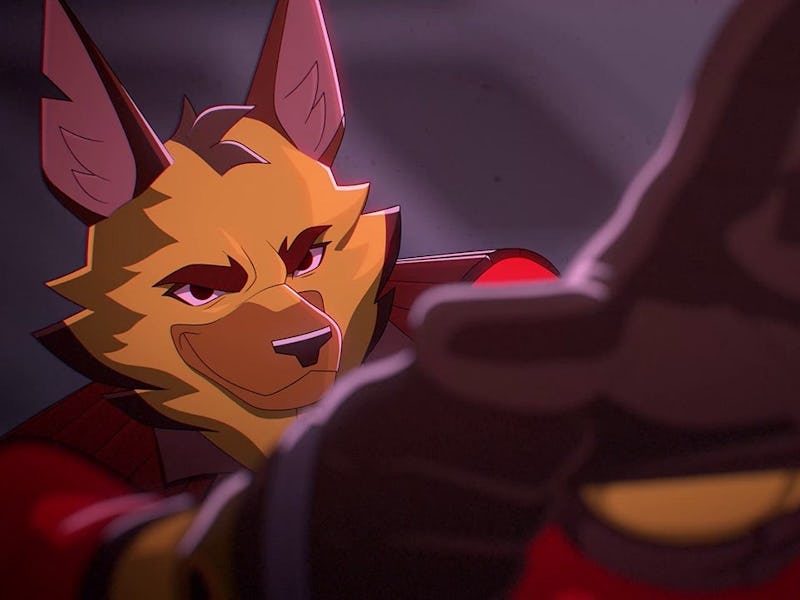
It’s been an agonizing nine years since the last Star Fox game, and nothing’s been able to fill that hole. But after all this time, Wild Blue Skies might be the fix fans have been looking for.
Star Fox comparisons are inevitable for any rail shooter that has you controlling a furry spaceship pilot, but the team behind Wild Blue Skies wants to explore what new ideas could be possible for the genre.
“For Wild Blue Skies, we really honed in on rail shooters being amazing vehicles for characters and storytelling,” a Chuhai Labs representative tells Inverse. “We focused on creating a world players want to discover with fun characters to meet along the way, bringing in some of that '90s Saturday morning cartoon feeling with it.”
The void left by Star Fox presents a prime opportunity for a bold game to seize its place. Revealed earlier this year as Wild Blue, Chuhai Labs re-unveiled the game as Wild Blue Skies this week in a big new gameplay trailer. The studio already has expertise with this style of game, as it’s led by Giles Goddard, a programmer on the original SNES Star Fox.
Alongside the game’s second reveal, Inverse spoke to Chuhai Labs about the ambitions of Wild Blue Skies, crafting charming anthropomorphic characters, and that inevitable Star Fox comparison.
This interview has been edited for clarity and brevity.
How did you land on Wild Blue Skies’ art style? Were there any other aesthetics you considered?
Chuhai Labs: From the very beginning, we wanted to capture the rendering style found in classic Studio Ghibli animations, from Nausicaä to Porco Rosso. This meant having painterly backgrounds and rich environments, with strong cel-shaded heroes and enemies to make them pop off the screen. This process went through plenty of iterations, from simplifying the background details to defining the rules for when to toon-shade an environmental object and when to render it more stylistically.
What references did you look at in terms of ship design? I’m especially curious about what inspired the player’s ships.
Chuhai Labs: As the player would be looking at their ship for the entirety of the game, we spent a long time going through different designs to sell its unique movements and help it stand out during gameplay.
The final Cloudcutter you see was born from a single doodle among a collection of silhouettes exploring new design ideas. The back view with a giant concentric ring and six splayed wingtips stood out to us, so we worked from there to define how the rest of the vehicle looked. It needed to be able to change its wingspan based on formation needs, to have a large cockpit windshield for viewing the heroes, and, most importantly, to feel like a dynamic ship built for speed and action. We're very proud of the results.
Wild Blue Skies has a vibrant and colorful style inspired by anime classics.
How did you decide on the length of the game? Rail shooters are usually fast-paced, so how do you give players enough to do without overstaying your welcome?
Chuhai Labs: We wanted each mission to feel like an action-packed, bite-sized episode of a grander adventure. The key was balancing the minute-to-minute gameplay and giving you a nice mix of high-intensity action and moments of respite, all meshed together with fun dialogue.
How do you decide on which animals each character will be? Do you start with a personality, or start with the animal in mind?
Chuhai Labs: For the Blue Bombers, their personalities always came first. From there, we went through dozens of species to find the best fit for each member. Even [main character] Bowie went through multiple dog breeds until we landed on the German Shepherd to capture his cockiness and leadership. The three remaining crew members were chosen not only for their personalities, but also to have some variation between sizes and textures when they're seen together.
All of the evil characters, from boss pilots to [rival pilot group] The Prowlers, were chosen mostly based on their looks, again to have a well-rounded group of diverse animals that would be acceptable for their roles. Grimclaw, the main antagonist, could only have been one of a few apex predators, but the others had more options available.
Wild Blue Skies features an eclectic cast of wingmen.
Wild Blue Skies is obviously going to draw comparisons to Star Fox. How do you work with the assumptions that players will have going in?
Chuhai Labs: We made Wild Blue Skies as huge fans of the genre, and wanted to make something new in that space. A lot of us at Chuhai grew up in the 3D era of 3D-accelerated PC graphics cards, PlayStation, N64, and the SEGA Saturn, and we wanted this game to evoke the feelings we remember from that time.
This style of single-player rail shooter has become increasingly rare. Why do you think the genre has been absent over the last decade? And how can it appeal to new audiences in 2025?
Chuhai Labs: Although these types of games aren’t as prevalent as they used to be, there's lots of cool titles being made in this genre! We think there's something timeless about going on an adventure with a bunch of fun characters, and we hope Wild Blue Skies will make for an experience everyone can pick up and enjoy.
Have you thought about expanding Wild Blue Skies beyond this single game? Do you think there’s potential for more, or is this a one-off homage?
Chuhai Labs: Building Wild Blue Skies' world has been a blast — we'd love to tell more stories in it!